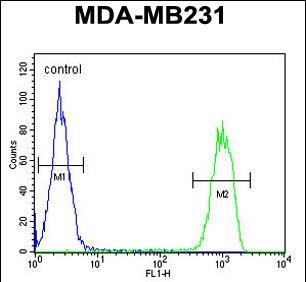CJ119 Antibody (N-term)
Affinity Purified Rabbit Polyclonal Antibody (Pab)
- SPECIFICATION
- CITATIONS
- PROTOCOLS
- BACKGROUND

Application
| FC, IHC-P, WB, E |
|---|---|
| Primary Accession | Q9BTE3 |
| Other Accession | B1H268, Q8R3C0, A5PJM5 |
| Reactivity | Human |
| Predicted | Bovine, Mouse, Rat |
| Host | Rabbit |
| Clonality | Polyclonal |
| Isotype | Rabbit IgG |
| Calculated MW | 72980 Da |
| Antigen Region | 143-171 aa |
| Gene ID | 79892 |
|---|---|
| Other Names | Mini-chromosome maintenance complex-binding protein, MCM-BP, MCM-binding protein, MCMBP, C10orf119 |
| Target/Specificity | This CJ119 antibody is generated from rabbits immunized with a KLH conjugated synthetic peptide between 143-171 amino acids from the N-terminal region of human CJ119. |
| Dilution | FC~~1:10~50 IHC-P~~1:50~100 WB~~1:1000 E~~Use at an assay dependent concentration. |
| Format | Purified polyclonal antibody supplied in PBS with 0.09% (W/V) sodium azide. This antibody is purified through a protein A column, followed by peptide affinity purification. |
| Storage | Maintain refrigerated at 2-8°C for up to 2 weeks. For long term storage store at -20°C in small aliquots to prevent freeze-thaw cycles. |
| Precautions | CJ119 Antibody (N-term) is for research use only and not for use in diagnostic or therapeutic procedures. |
| Name | MCMBP |
|---|---|
| Synonyms | C10orf119 |
| Function | Associated component of the MCM complex that acts as a regulator of DNA replication. Binds to the MCM complex during late S phase and promotes the disassembly of the MCM complex from chromatin, thereby acting as a key regulator of pre-replication complex (pre-RC) unloading from replicated DNA. Can dissociate the MCM complex without addition of ATP; probably acts by destabilizing interactions of each individual subunits of the MCM complex. Required for sister chromatid cohesion. |
| Cellular Location | Nucleus. Note=Associates with chromatin. Highly associated with chromatin in G1/S and S phases, reduced binding to chromatin in G2, and further decreased binding in early M phase. It then reassociates with chromatin in late M phase. Dissociates from chromatin later than component of the MCM complex |

Thousands of laboratories across the world have published research that depended on the performance of antibodies from Abcepta to advance their research. Check out links to articles that cite our products in major peer-reviewed journals, organized by research category.
info@abcepta.com, and receive a free "I Love Antibodies" mug.
Provided below are standard protocols that you may find useful for product applications.
Background
CJ119 is a carefully orchestrated process involving many proteins that assemble at origins of replication. Among these are the 6 proteins of the minichromosome maintenance (MCM) complex (e.g., MCM2; MIM 116945), which form a hexamer. Each MCM subunit performs an essential function in initiation and elongation of DNA replication. MCMBP can replace MCM2 in the MCM complex, thus forming an alternative MCM hexamer.
References
Takahashi, N., et al. PLoS Genet. 6 (1), E1000817 (2010)
Sugiyama, N., et al. Mol. Cell Proteomics 6(6):1103-1109(2007)
Sakwe, A.M., et al. Mol. Cell. Biol. 27(8):3044-3055(2007)
If you have used an Abcepta product and would like to share how it has performed, please click on the "Submit Review" button and provide the requested information. Our staff will examine and post your review and contact you if needed.
If you have any additional inquiries please email technical services at tech@abcepta.com.













 Foundational characteristics of cancer include proliferation, angiogenesis, migration, evasion of apoptosis, and cellular immortality. Find key markers for these cellular processes and antibodies to detect them.
Foundational characteristics of cancer include proliferation, angiogenesis, migration, evasion of apoptosis, and cellular immortality. Find key markers for these cellular processes and antibodies to detect them. The SUMOplot™ Analysis Program predicts and scores sumoylation sites in your protein. SUMOylation is a post-translational modification involved in various cellular processes, such as nuclear-cytosolic transport, transcriptional regulation, apoptosis, protein stability, response to stress, and progression through the cell cycle.
The SUMOplot™ Analysis Program predicts and scores sumoylation sites in your protein. SUMOylation is a post-translational modification involved in various cellular processes, such as nuclear-cytosolic transport, transcriptional regulation, apoptosis, protein stability, response to stress, and progression through the cell cycle. The Autophagy Receptor Motif Plotter predicts and scores autophagy receptor binding sites in your protein. Identifying proteins connected to this pathway is critical to understanding the role of autophagy in physiological as well as pathological processes such as development, differentiation, neurodegenerative diseases, stress, infection, and cancer.
The Autophagy Receptor Motif Plotter predicts and scores autophagy receptor binding sites in your protein. Identifying proteins connected to this pathway is critical to understanding the role of autophagy in physiological as well as pathological processes such as development, differentiation, neurodegenerative diseases, stress, infection, and cancer.




